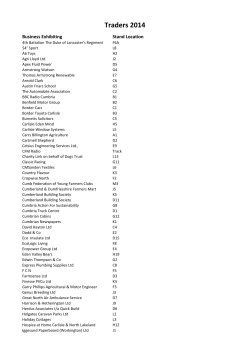
How to interpret LASS profiles LASS Report Interpretation www.lucid-research.com © Lucid Research Ltd
LASS Report Interpretation How to interpret LASS profiles © Lucid Research Ltd www.lucid-research.com LASS Report Interpretation Outline of presentation The tests in LASS Types of scores used in LASS Discrepancies and age equivalents Steps in interpretation of results Some illustrative profiles Limitations of the single word reading test • LASS and the SEN Code of Practice • • • • • • © Lucid Research Ltd www.lucid-research.com LASS Report Interpretation The tests in LASS ATTAINMENT TESTS DIAGNOSTIC TESTS © Lucid Research Ltd Cave / Haunted Cave (Visual memory) Mobile / Mobile Phone (Auditory memory) Single word reading Sentence reading Spelling Nonwords / Funny Words (phonic skills) ABILITY TEST Syllables / Word Chopping / (phonological processing) www.lucid-research.com Non-verbal reasoning LASS Report Interpretation Types of scores used in LASS Secondary • Raw scores (number correct or pass rates) • Projected scores (scores adjusted to allow for the adaptive algorithm in each test) • Centile scores (range 1– 99) – used for general comparison purposes • z scores (standard deviation units) – these are equivalent to standard scores and can be used for calculating discrepancy if required • Age equivalents (like a reading age or spelling age) © Lucid Research Ltd www.lucid-research.com LASS Report Interpretation LASS results The main LASS results are in the form of a graphical profile Scores for each test are shown in centiles © Lucid Research Ltd www.lucid-research.com LASS Report Interpretation Changing from centile scores to z scores Click here to change from centiles to z scores z scores have a mean (average) of zero and a standard deviation of 1 z scores can be converted to standard scores (average 100, standard deviation 15) © Lucid Research Ltd www.lucid-research.com LASS Report Interpretation Changing from graphical profile to data summary Click here © Lucid Research Ltd www.lucid-research.com LASS Report Interpretation z scores • z scores have a mean (average) of zero and a standard deviation of 1 • z scores can easily be converted to standard scores (average 100, standard deviation 15) © Lucid Research Ltd www.lucid-research.com LASS Report Interpretation Data pages • For each test full results for every item can be accessed • All results can be printed out or archived for future reference © Lucid Research Ltd www.lucid-research.com LASS Report Interpretation Summary table © Lucid Research Ltd www.lucid-research.com LASS Report Interpretation Discrepancies and age equivalents © Lucid Research Ltd www.lucid-research.com LASS Report Interpretation Discrepancy • As well as looking at a pupil’s scores on each individual LASS Secondary test, the teacher can compare scores across different LASS Secondary tests for that pupil. • Where scores appear to be different, it can be helpful to know whether this difference is just a chance variation or whether it represents a real discrepancy. • This cannot be established from centile scores. Instead, z scores must be used. • Comparing z scores on different tests enables statistical discrepancy to be calculated. Differences more than about 0.66 (two thirds of a z score) will be statistically significant. • For further information, see the LASS Secondary Teacher’s Manual (section 4.3.3). • The Summary Table provides calculated discrepancies between the Reasoning score and the scores obtained on all the other tests. © Lucid Research Ltd www.lucid-research.com LASS Report Interpretation Basic steps in profile interpretation 1. READ the manual 2. Compare reasoning score with literacy scores: is the pupil under-performing in literacy? 3. Are literacy problems explainable in terms of: • Memory deficiencies, and or • Phonological deficiencies? 4. What strengths does the pupil have? © Lucid Research Ltd www.lucid-research.com LASS Report Interpretation 92 © Lucid Research Ltd 20 S-W Reading www.lucid-research.com Reasoning 10 2 Segments Nonwords 4 Spelling 16 15 Sentence Reading 23 Mobile 100 90 80 70 60 50 40 30 20 10 0 Cave Centile score ‘Classic severe dyslexic’ profile LASS Report Interpretation ‘Classic dyslexic’ with strength in visual memory 100 92 90 80 Centile score 70 67 60 50 40 34 28 30 20 10 20 16 15 4 © Lucid Research Ltd www.lucid-research.com Reasoning Spelling Sentence Reading SW Reading Segments Nonwords Mobile Cave 0 LASS Report Interpretation 87 65 48 36 © Lucid Research Ltd 29 www.lucid-research.com Reasoning Spelling 20 Sentence Reading S-W Reading 14 Segments Nonwords 15 Mobile 100 90 80 70 60 50 40 30 20 10 0 Cave Centile score ‘Mild dyslexic / SpLD’ profile LASS Report Interpretation © Lucid Research Ltd 42 42 38 29 28 16 www.lucid-research.com Spelling Sentence Reading S-W Reading Segments Nonwords 12 Reasoning 36 Mobile 100 90 80 70 60 50 40 30 20 10 0 Cave Centile score ‘Below average ability’ profile LASS Report Interpretation ‘Low ability’ profile 100 90 80 Centile score 70 60 50 40 25 30 20 18 10 12 Cave Mobile 20 14 8 10 7 © Lucid Research Ltd www.lucid-research.com Reasoning Spelling Sentence Reading SW Reading Segments Nonwords 0 LASS Report Interpretation ‘Fluency deficit’ profile 100 86 90 75 80 Centile score 70 68 67 56 60 50 43 36 40 30 20 20 10 © Lucid Research Ltd www.lucid-research.com Reasoning Spelling Sentence Reading SW Reading Segments Nonwords Mobile Cave 0 LASS Report Interpretation ‘Visual memory deficit’ profile 100 90 75 80 68 Centile score 70 56 60 50 43 40 30 30 16 20 10 7 6 © Lucid Research Ltd www.lucid-research.com Reasoning Spelling Sentence Reading SW Reading Segments Nonwords Mobile Cave 0 LASS Report Interpretation ‘High ability’ profile with auditory memory weakness 99 100 99 95 90 90 85 82 79 80 Centile score 70 60 50 37 40 30 20 10 © Lucid Research Ltd www.lucid-research.com Reasoning Spelling Sentence Reading SW Reading Segments Nonwords Mobile Cave 0 LASS Report Interpretation Limitations of the single word reading test Number of individuals Low Average SCORE Normal distribution of scores © Lucid Research Ltd High Low www.lucid-research.com Number of individuals Skewed distribution of scores Average High SCORE LASS Report Interpretation Using the single word reading test • Test scores in all the tests in LASS are ‘normally distributed’ except the Single Word Reading Test (SWRT). • The score distribution on SWRT is ‘negatively skewed’, because most pupils do very well on it. • This means that the test does not discriminate clearly between good readers and average readers, but it does help to identify poor readers. • There is little point in giving LASS SWRT test to good or average readers, i.e. those over centile 20 on the Sentence Reading test. © Lucid Research Ltd www.lucid-research.com LASS Report Interpretation Conclusions • LASS is a multifunctional test providing data that can serve many educational purposes, including helping to understand SEN and when considering a pupil for placement on the SEN register. • The graphical profile and summary table of results provide the majority of the information that teachers need from the program. • Many profiles approximate to common types (as illustrated), which are straightforward to interpret, either visually or using the discrepancy data. • More complex or usual profiles require further analysis. © Lucid Research Ltd www.lucid-research.com
© Copyright 2025









